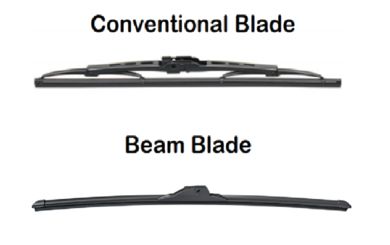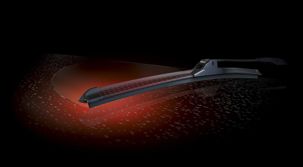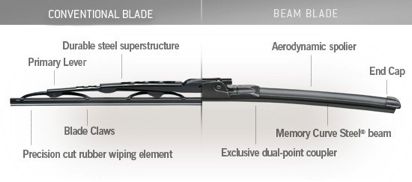Ice, snow, and incessant teeth-chattering—there are plenty of things that impair your ability to see the road when driving during winter. A dirty windshield shouldn’t be one of them! Reliable wiper blades can make the difference between keeping your eyes on the road and seeing nothing but ice on your windshield. If you’re replacing yours this season, use the following points to determine whether conventional or beam wiper blades are best for your car.
Differences Between Conventional vs. Beam Wiper Blades
1. Conventional blades are straighter than beam wiper blades.
Beam wiper blades are more curved than conventional ones. This extra curvature enhances their ability to “hug” the contours of your windshield, allowing them to apply more pressure for a clearer line of sight. If you switch from conventional to beam wiper blades, you can expect to see the most noticeable difference on the passenger-side windshield. Compare their design side-by-side in the image below.
Due to their straighter design, conventional or traditional blades only make contact with the windshield at six-to-eight points. In contrast, beam blades have infinite pressure points since their entire length makes tight contact with the windshield. More pressure points mean a more thorough clean.
2. Beam wiper blades are more wind-resistant than conventional blades.
Contrary to popular belief, rain and snow aren’t the only things that affect your vision. The wind does, too. High-speed winds create more air resistance, often called “drag”. In turn, drag “lifts” conventional blades away from the windshield. This phenomenon is known as wind lift. As your wiper blades lose contact with your windshield, you lose sight of the road. Premium beam blades resist wind resistance by turning it into pressure, which they leverage to clean your windshield more effectively.
3. They’re built with different materials.
In general, conventional wiper blades consist of a replaceable rubber blade that snaps into several contact points on a metal frame. Each contact point has a spring, which serves the purpose of applying pressure to the windshield. However, since there’s a finite number of springs on each blade, conventional blades tend to squeegee windshields less evenly than beam blades.
Premium beam blades utilize high-strength steel and high-quality rubber, which helps them last longer and endure harsher road conditions. Additionally, they have no exposed parts, preventing ice and snow from building up on them. For drivers living in areas with harsh winters, unpredictable summers, and everything in between, beam blades are the superior choice.
See the Difference Yourself
Still not sure whether you want conventional wiper blades or beam ones? Stop by your local Firestone Complete Auto Care to get a clearer picture of how these two types of wiper blades differ. We’ll help you find the right TRICO wiper blades for your car and install them on-the-spot so you can drive off with a better view of the road ahead.






